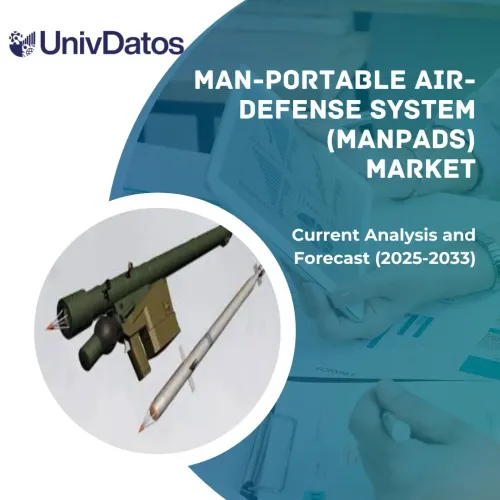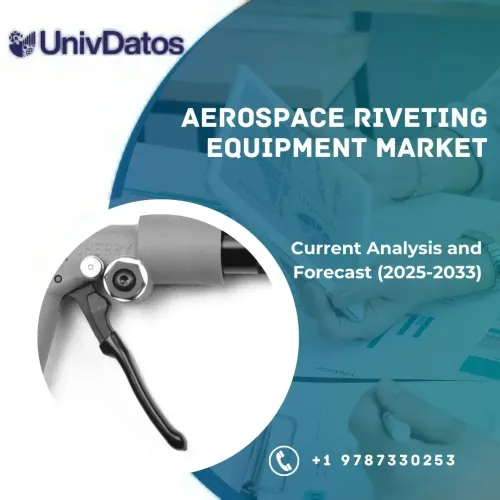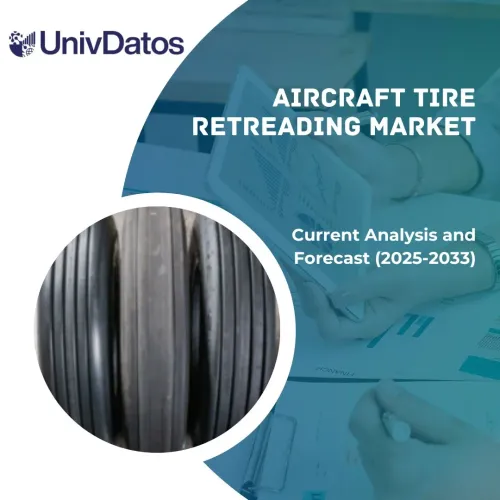- Inicio
- Acerca de nosotros
- Industria
- Servicios
- Leyendo
- Contáctenos
Mercado de vehículos de rescate subsuperficial: Análisis y pronóstico actual (2023-2030)
Énfasis en el tipo (Vehículo de operación remota, Vehículo subsuperficial autónomo y Vehículo subsuperficial híbrido), Usuario final (Industria del petróleo y el gas, La industria minera, La industria marítima, Puertos y puertos deportivos, Monitoreo y limpieza ambiental, Operación de búsqueda y rescate, Construcción y mantenimiento submarinos y Investigación y mantenimiento científicos), y Región/País
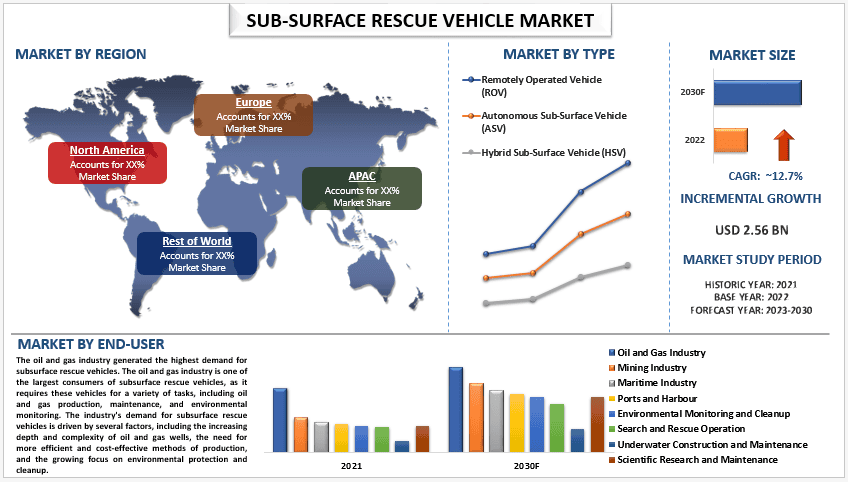
El mercado de vehículos de rescate subsuperficial se valoró en 2.56 mil millones en el año 2022 y se espera que crezca a un ritmo constante de alrededor del 12.7% durante el período de pronóstico (2023-2030), debido a la creciente exploración subterránea y submarina.Además, el aumento de la frecuencia y la gravedad de los desastres naturales, como terremotos, huracanes e inundaciones, está provocando una creciente demanda de vehículos de rescate subsuperficiales. Los desastres naturales a menudo resultan en una destrucción generalizada y pérdida de vidas, lo que lleva a una mayor necesidad de operaciones de rescate para salvar a los atrapados o heridos. Los vehículos de rescate subsuperficiales están diseñados para navegar a través de infraestructuras dañadas y llegar a los necesitados. Además, los desastres naturales pueden causar emergencias generalizadas como inundaciones, incendios y fugas de gas. Los vehículos de rescate subsuperficiales pueden navegar a través de las áreas afectadas y llegar a los necesitados. Adicionalmente, con el aumento de las actividades oceánicas, existe un mayor riesgo de que ocurran accidentes, como derrames de petróleo, fugas de gas y fallas de equipos. Esto requiere el uso de vehículos de rescate subsuperficiales para responder rápida y eficazmente a estos incidentes. Con el aumento de las actividades oceánicas, existe una mayor necesidad de operaciones de búsqueda y rescate. Los vehículos de rescate subsuperficiales son necesarios para localizar y rescatar a las personas que puedan estar atrapadas o varadas en entornos submarinos.
OBTENER UNA MUESTRA DEL INFORME
Algunos de los principales actores que operan en el mercado son BAE Systems; Teledyne Technologies; L3Harris Technologies, Inc.; Lockheed Martin Corporation.; Oceaneering International, Inc.; SAAB; Fugro; General Dynamics Corporation; International Submarine Engineering Limited; y KONGSBERG. Varias fusiones y adquisiciones junto con asociaciones han sido realizadas por estos actores para facilitar a los clientes productos/tecnologías innovadores y de alta tecnología.
Información clave presentada en el informe
“Entre los tipos, se prevé que el segmento de vehículos subsuperficiales autónomos (ASV) crezca a una CAGR significativa durante el período de pronóstico (2023-2030).”
Sobre la base del tipo, el mercado está segmentado en vehículo de operación remota (ROV), vehículo subsuperficial autónomo (ASV) y vehículo subsuperficial híbrido (HSV). Se prevé que los vehículos subsuperficiales autónomos (ASV) sean testigos de una tasa de crecimiento significativa en términos de CAGR durante el período de pronóstico. Varios factores jugarán un papel importante que conducirán a un alto crecimiento de los ASV, como una mayor seguridad, donde los ASV están diseñados para operar de forma autónoma, lo que reduce el riesgo de error humano. Además, los ASV pueden operar durante períodos de tiempo más largos y cubrir áreas más grandes que los ROV, lo que los hace más eficientes para las operaciones de búsqueda y rescate. Además de esto, los ASV están equipados con sensores avanzados y sistemas de comunicación, lo que les permite operar en una variedad de entornos y realizar una gama de tareas, como mapeo, inspección y limpieza submarina. Además, los ASV pueden operar en áreas que son difíciles o imposibles de alcanzar para los ROV, como en aguas profundas o en áreas con terrenos submarinos complejos. Estos son algunos de los factores responsables de la creciente demanda de ASV y también se pueden ver en los recientes lanzamientos de productos en este espacio.
“Entre los usuarios finales, el segmento de la industria del petróleo y el gas tiene la mayor parte del mercado en el año 2022.”
Según el usuario final, el mercado se segmenta en la industria del petróleo y el gas, la industria minera, la industria marítima, puertos y puertos deportivos, monitoreo y limpieza ambiental, operación de búsqueda y rescate, construcción y mantenimiento submarinos e investigación y mantenimiento científicos. La industria del petróleo y el gas generó la mayor demanda de vehículos de rescate subsuperficiales. La industria del petróleo y el gas es uno de los mayores consumidores de vehículos de rescate subsuperficiales, ya que requiere estos vehículos para una variedad de tareas, incluida la producción de petróleo y gas, el mantenimiento y el monitoreo ambiental. La demanda de vehículos de rescate subsuperficiales por parte de la industria está impulsada por varios factores, incluida la creciente profundidad y complejidad de los pozos de petróleo y gas, la necesidad de métodos de producción más eficientes y rentables y el creciente enfoque en la protección y limpieza ambiental. Una de las tendencias clave que impulsan la demanda de vehículos de rescate subsuperficiales en la industria del petróleo y el gas es el creciente uso de vehículos autónomos y de operación remota (ROV) para tareas submarinas. Estos vehículos pueden operar de forma independiente, sin la necesidad de un operador humano, lo que reduce el riesgo de accidentes y aumenta la eficiencia de las operaciones. Además, el uso de ROV permite una recopilación de datos más precisa y exacta, lo cual es fundamental en la industria del petróleo y el gas. Además, la industria marítima también es un consumidor clave de vehículos de rescate subsuperficiales, ya que requiere estos vehículos para una variedad de tareas, incluida la inspección y el mantenimiento submarinos y el monitoreo ambiental.
“Norteamérica tiene la mayor parte del mercado en el año 2022.”
La región con el mercado más grande de vehículos de rescate subsuperficiales es América del Norte. Esto se debe a una combinación de factores, como las altas inversiones en este espacio, el creciente uso por parte de las armadas y los ejércitos, la disponibilidad de tecnología y el creciente desarrollo de productos tanto por parte de empresas privadas como de agencias gubernamentales. Los gobiernos y las empresas privadas han estado invirtiendo fuertemente en tecnologías de rescate subsuperficiales, lo que ha llevado al desarrollo de sistemas y equipos avanzados. Además, la disponibilidad de tecnologías avanzadas como vehículos submarinos autónomos (AUV), vehículos de operación remota (ROV) y vehículos submarinos no tripulados (UUV) ha hecho que las operaciones de rescate subsuperficiales sean más eficientes y efectivas. Esta tecnología ha permitido a las armadas y los ejércitos realizar tareas complejas como la detección de minas, la vigilancia submarina y el monitoreo ambiental. Además, las armadas y los ejércitos utilizan cada vez más vehículos de rescate subsuperficiales para diversos fines, como operaciones de búsqueda y rescate, exploración submarina y monitoreo ambiental. Este mayor uso ha creado una demanda de estos vehículos, lo que ha impulsado el mercado hacia adelante. Este aumento de la demanda de vehículos de rescate subsuperficiales en América del Norte también se puede ver en los recientes lanzamientos de productos que ocurren en este espacio.Por ejemplo, en diciembre de 2022, la Armada de los EE. UU. demostró un sistema de lanzamiento y recuperación de UUV (vehículo submarino no tripulado) de gran tamaño. La demostración mostró tanto un enfoque de lanzamiento y recuperación terrestre como una solución novedosa para lanzar vehículos submarinos no tripulados (UUV) de gran tamaño desde barcos anfibios.
Cobertura del informe del mercado de vehículos de rescate subsuperficiales
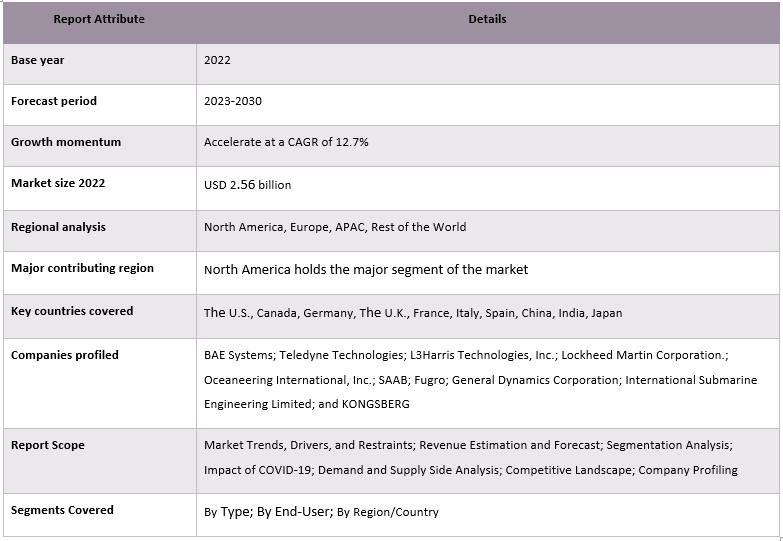
Razones para comprar este informe:
- El estudio incluye análisis de dimensionamiento y pronóstico del mercado validados por expertos clave de la industria autenticados.
- El informe presenta una revisión rápida del rendimiento general de la industria de un vistazo.
- El informe cubre un análisis en profundidad de los principales competidores de la industria con un enfoque principal en las finanzas comerciales clave, las carteras de productos, las estrategias de expansión y los desarrollos recientes.
- Examen detallado de los impulsores, las restricciones, las tendencias clave y las oportunidades que prevalecen en la industria.
- El estudio cubre ampliamente el mercado en diferentes segmentos.
- Análisis de nivel regional en profundidad de la industria.
Opciones de personalización:
El mercado global de vehículos de rescate subsuperficiales se puede personalizar aún más según el requisito o cualquier otro segmento de mercado. Además de esto, UMI entiende que puede tener sus propias necesidades comerciales, por lo tanto, no dude en contactarnos para obtener un informe que se adapte completamente a sus requisitos.
Tabla de contenido
Metodología de investigación para el análisis del mercado de vehículos de rescate subsuperficiales (2023-2030)
Analizar el mercado histórico, estimar el mercado actual y pronosticar el mercado futuro del mercado global de vehículos de rescate subsuperficiales fueron los tres pasos principales emprendidos para crear y analizar la adopción de vehículos de rescate subsuperficiales en las principales regiones a nivel mundial. Se realizó una exhaustiva investigación secundaria para recopilar los números históricos del mercado y estimar el tamaño actual del mercado. En segundo lugar, para validar estos conocimientos, se tomaron en consideración numerosos hallazgos y supuestos. Además, también se realizaron exhaustivas entrevistas primarias con expertos de la industria en toda la cadena de valor del mercado global de vehículos de rescate subsuperficiales. Después de la suposición y validación de los números del mercado a través de entrevistas primarias, empleamos un enfoque de arriba hacia abajo/abajo hacia arriba para pronosticar el tamaño completo del mercado. Posteriormente, se adoptaron métodos de desglose del mercado y triangulación de datos para estimar y analizar el tamaño del mercado de los segmentos y subsegmentos de la industria. La metodología detallada se explica a continuación:
Análisis del tamaño histórico del mercado
Paso 1: Estudio en profundidad de fuentes secundarias:
Se realizó un estudio secundario detallado para obtener el tamaño histórico del mercado del mercado de vehículos de rescate subsuperficiales a través de fuentes internas de la empresa, comoinformes anuales y estados financieros, presentaciones de rendimiento, comunicados de prensa, etc.,y fuentes externas que incluyenrevistas, noticias y artículos, publicaciones gubernamentales, publicaciones de la competencia, informes sectoriales, bases de datos de terceros y otras publicaciones creíbles.
Paso 2: Segmentación del mercado:
Después de obtener el tamaño histórico del mercado del mercado de vehículos de rescate subsuperficiales, realizamos un análisis secundario detallado para recopilar información y cuotas históricas del mercado para diferentes segmentos y subsegmentos de las principales regiones. Los principales segmentos se incluyen en el informe como tipo y usuario final. Además, se realizaron análisis a nivel de país para evaluar la adopción general de los modelos de prueba en esa región.
Paso 3: Análisis de factores:
Después de adquirir el tamaño histórico del mercado de diferentes segmentos y subsegmentos, realizamos un detalladoanálisis de factorespara estimar el tamaño actual del mercado del mercado de vehículos de rescate subsuperficiales. Además, realizamos un análisis de factores utilizando variables dependientes e independientes, como conectividad, usuario final y aplicación del mercado de vehículos de rescate subsuperficiales. Se realizó un análisis exhaustivo de los escenarios de la oferta y la demanda considerando las principales asociaciones, fusiones y adquisiciones, la expansión comercial y los lanzamientos de productos en el sector del mercado de vehículos de rescate subsuperficiales en todo el mundo.
Estimación y pronóstico del tamaño actual del mercado
Dimensionamiento del mercado actual:Basándonos en la información útil de los 3 pasos anteriores, llegamos al tamaño actual del mercado, los actores clave en el mercado global de vehículos de rescate subsuperficiales y las cuotas de mercado de los segmentos. Todas las cuotas porcentuales divididas requeridas y los desglose del mercado se determinaron utilizando el enfoque secundario mencionado anteriormente y se verificaron a través de entrevistas primarias.
Estimación y pronóstico:Para la estimación y el pronóstico del mercado, se asignaron pesos a diferentes factores, incluidos los impulsores y las tendencias, las restricciones y las oportunidades disponibles para las partes interesadas. Después de analizar estos factores, se aplicaron técnicas de pronóstico relevantes, es decir, el enfoque de arriba hacia abajo/abajo hacia arriba para llegar al pronóstico del mercado para 2030 para diferentes segmentos y subsegmentos en los principales mercados a nivel mundial. La metodología de investigación adoptada para estimar el tamaño del mercado abarca:
- El tamaño del mercado de la industria, en términos de ingresos (USD) y la tasa de adopción del mercado de vehículos de rescate subsuperficial en los principales mercados a nivel nacional
- Todas las cuotas porcentuales, divisiones y desgloses de los segmentos y subsegmentos del mercado
- Actores clave en el mercado global de vehículos de rescate subsuperficial en términos de productos ofrecidos. Además, las estrategias de crecimiento adoptadas por estos actores para competir en el mercado de rápido crecimiento.
Validación del Tamaño y la Cuota de Mercado
Investigación Primaria:Se realizaron entrevistas en profundidad con los Líderes de Opinión Clave (KOL) incluyendo Ejecutivos de Alto Nivel (CXO/VPs, Jefe de Ventas, Jefe de Marketing, Jefe Operacional, Jefe Regional, Jefe de País, etc.) en las principales regiones. Los hallazgos de la investigación primaria se resumieron y se realizó un análisis estadístico para probar la hipótesis planteada. Las entradas de la investigación primaria se consolidaron con los hallazgos secundarios, convirtiendo así la información en conocimientos prácticos.
División de Participantes Primarios en Diferentes Regiones
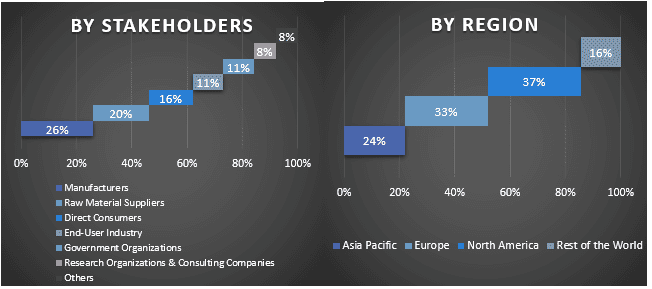
Ingeniería de Mercado
Se empleó la técnica de triangulación de datos para completar la estimación general del mercado y para llegar a números estadísticos precisos para cada segmento y subsegmento del mercado global de vehículos de rescate subsuperficial. Los datos se dividieron en varios segmentos y subsegmentos después de estudiar varios parámetros y tendencias en las áreas del tipo y el usuario final en el mercado global de vehículos de rescate subsuperficial.
El objetivo principal del Estudio del Mercado Global de Vehículos de Rescate Subsuperficial
Las tendencias actuales y futuras del mercado global de vehículos de rescate subsuperficial se identificaron en el estudio. Los inversores pueden obtener información estratégica para basar su discreción para las inversiones en el análisis cualitativo y cuantitativo realizado en el estudio. Las tendencias actuales y futuras del mercado determinaron el atractivo general del mercado a nivel regional, proporcionando una plataforma para que el participante industrial explote el mercado sin explotar para beneficiarse de una ventaja de primer motor. Otros objetivos cuantitativos de los estudios incluyen:
- Analizar el tamaño actual y previsto del mercado de vehículos de rescate subsuperficial en términos de valor (USD). Además, analizar el tamaño actual y previsto del mercado de diferentes segmentos y subsegmentos.
- Los segmentos en el estudio incluyen áreas de tipo y usuario final
- Definir y analizar el marco regulatorio para el vehículo de rescate subsuperficial
- Analizar la cadena de valor involucrada con la presencia de varios intermediarios, junto con el análisis de los comportamientos de los clientes y competidores de la industria
- Analizar el tamaño actual y previsto del mercado de vehículos de rescate subsuperficial para la región principal
- Los principales países de las regiones estudiadas en el informe incluyen Asia Pacífico, Europa, América del Norte y el Resto del Mundo
- Perfiles de empresas del mercado de vehículos de rescate subsuperficial y las estrategias de crecimiento adoptadas por los actores del mercado para sostenerse en el mercado de rápido crecimiento
- Análisis en profundidad a nivel regional de la industria
Relacionados Informes
Los clientes que compraron este artículo también compraron





